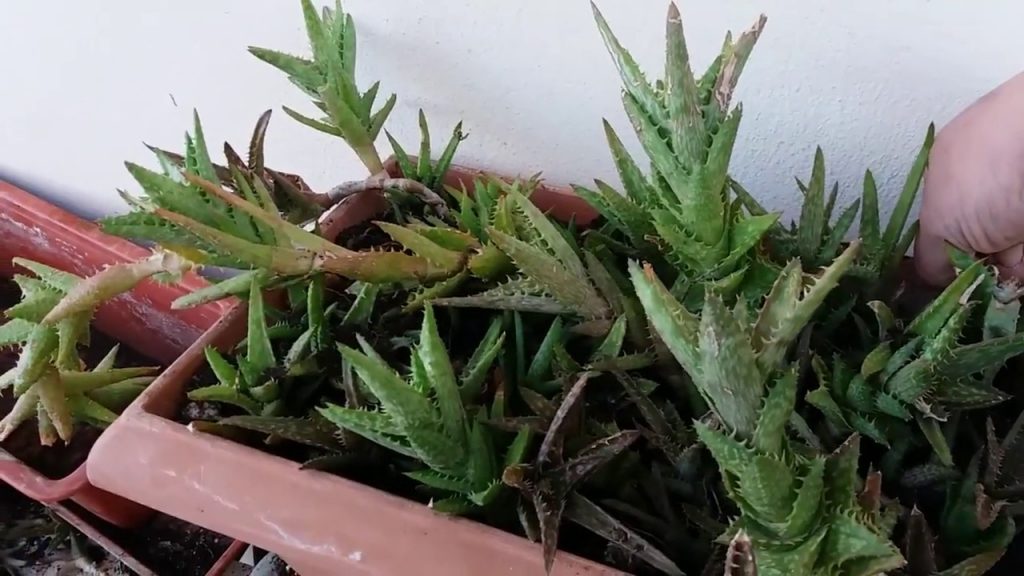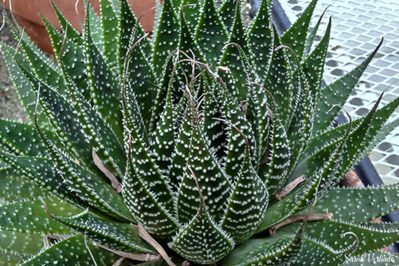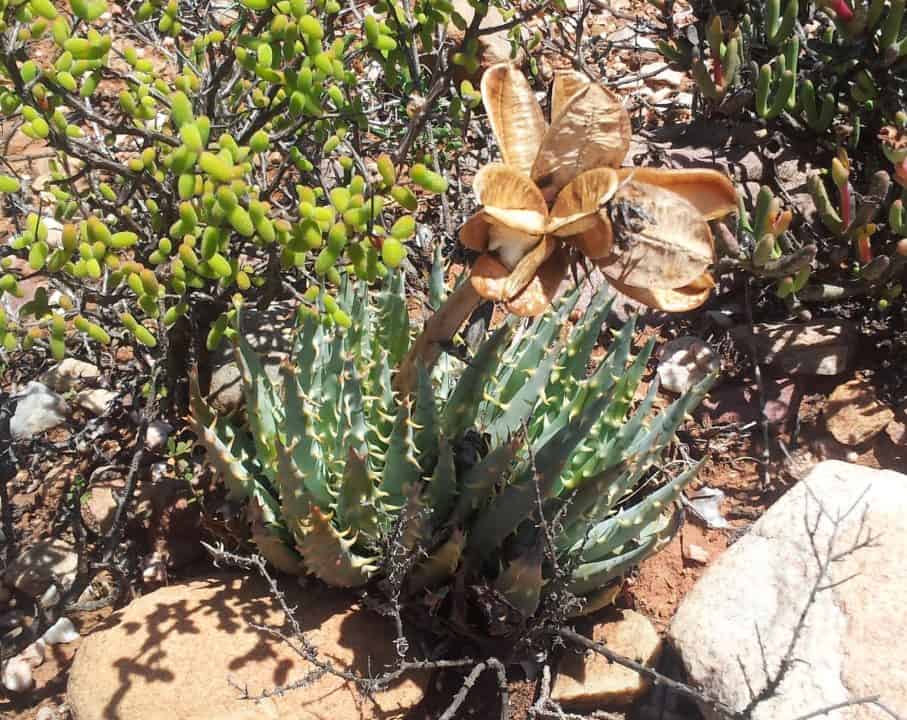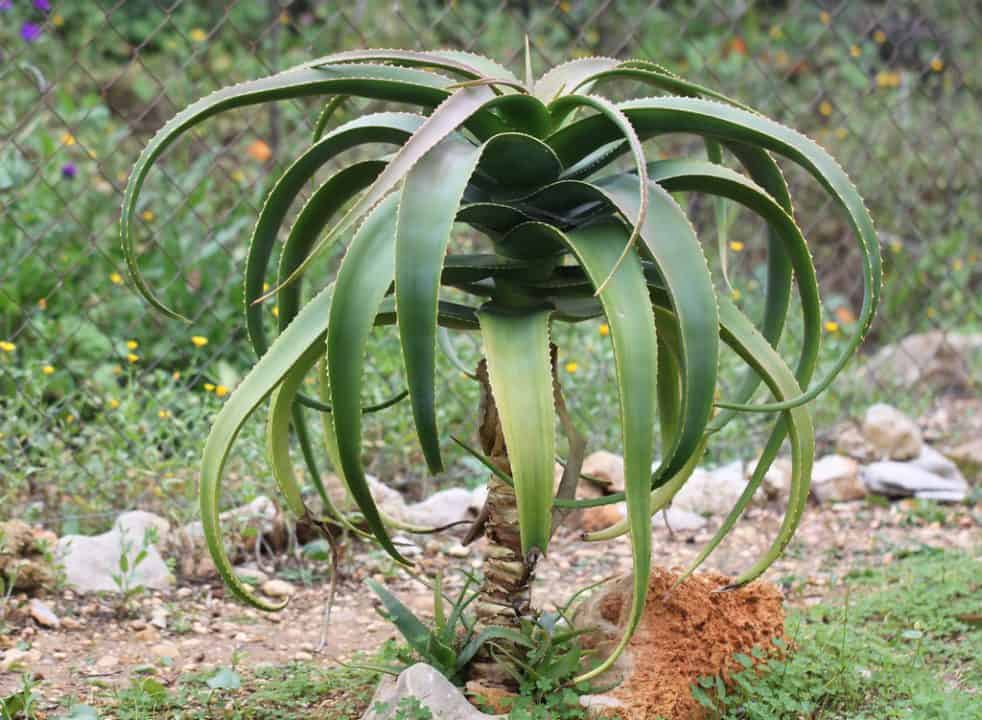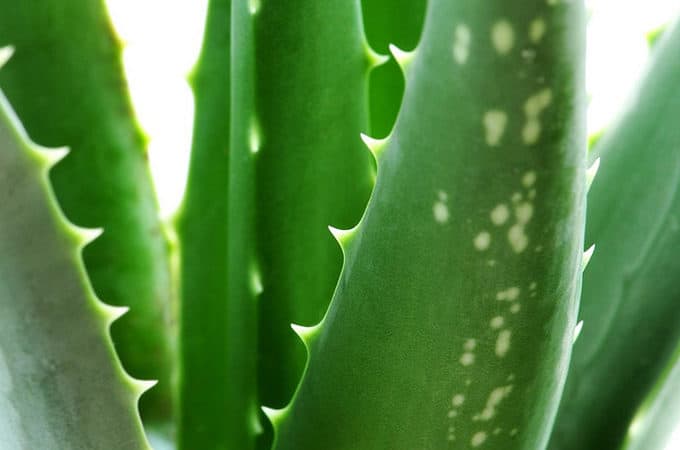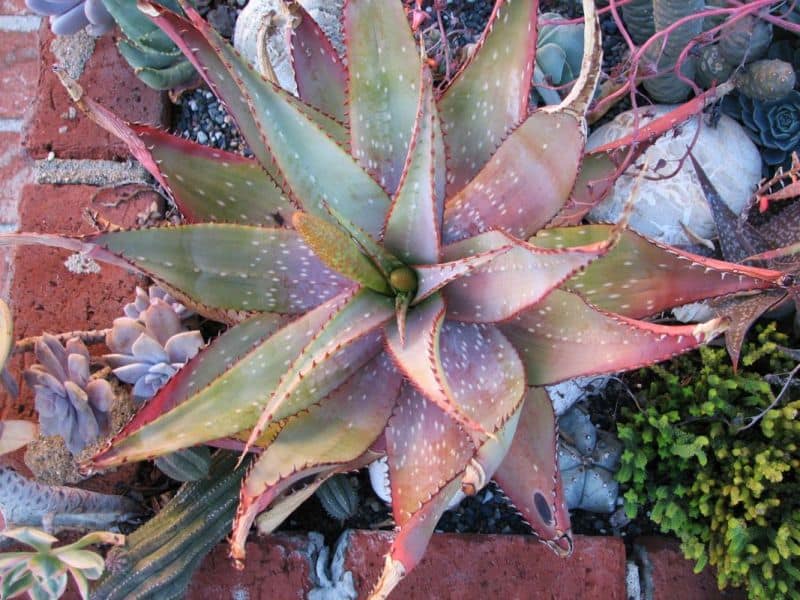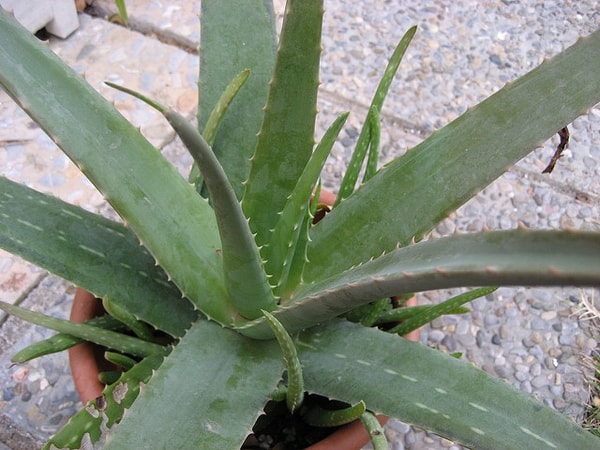Aloe juvenna, commonly known as tiger tooth aloe, shark tooth aloe, or tiger tooth succulent, has very wide leaves that can be up to 12 inches long and over an inch wide at the base. The leaves are semi-spherical with a sharp tip and serrated edges, making them look like they have teeth.
The texture of the leaves is also different from most other types of aloes in that it is more velvety to the touch rather than smooth and shiny. The dark green color of the leaves makes them stand out from other types of aloes, which typically have lighter-colored foliage.
If you’re new to succulents, consider starting your collection with an easy-to-grow plant such as the tiger tooth aloe. While this plant is no longer considered its own species, it’s still distinct enough from other types of aloe that it gets its own classification. Its common name comes from the fact that the leaves are similar in appearance to the teeth of a tiger and are arranged in an opposite manner along its stem.
The genus name juvenna means youthful in Latin, referring to the plant’s slow growth rate, and it may also be called tiger tooth aloe because of the tooth-like spines on its leaves and inflorescence. Despite its common name, Aloe juvenna does not closely resemble Aloe vera, which can be distinguished by its larger leaves with fewer spines on the edges.
Origin and distribution
Aloe juvenna is a type of aloe that originates from East Africa. It is also known as the tiger tooth succulent because of its sharp, pointy leaves. The plant can grow up to two feet tall and produces yellow or orange flowers. Aloe juvenna is relatively easy to care for and is a popular choice among succulent enthusiasts.
It is tolerant of dry climates and prefers full sun to thrive. Tiger tooth succulents are often propagated by dividing their offsets which grow on the stem or in between the spines. They should be watered regularly but do not require much attention other than occasional fertilizing with a diluted solution of fertilizer when plants are grown indoors in pots.
Tiger tooth aloes will grow best if they receive at least six hours of sunlight each day.
Plants may need more water during periods of high temperatures, especially if it does not rain frequently. To encourage new growth and promote blooming, cut off old flower spikes after flowering is completed.
Aloe juvenna propagation
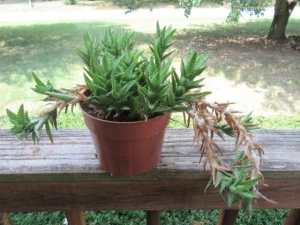
This aloe is best propagated by offsets or leaf cuttings. To propagate by offsets, simply remove the offset from the mother plant and pot it up in a well-draining cactus mix. For leaf cuttings, cut a leaf from the mother plant close to the base and allow it to callous over for a few days before potting it up in a well-draining cactus mix. Water the soil lightly and place the pot in a bright, sunny spot.
In 2-3 weeks, you should see roots beginning to grow on the leaves of your new plants. You can then transplant them into their own pots once they have fully developed roots. They are very sensitive to overwatering, so water sparingly and only when the topsoil becomes dry.
The aloe juvenna also likes bright light but not direct sunlight as this could scorch its leaves. It prefers being watered every other day in the winter while watering it daily during the summer months.
It is known to be an easy plant that grows quickly and tolerates temperature fluctuations quite well; this makes it an excellent houseplant.
Aloe juvenna care information
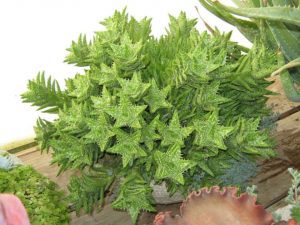
Aloe juvenna is a gorgeous plant that’s easy to care for. It thrives in bright light and only needs to be watered about once a week. Let the soil dry out completely between watering.
This plant is tolerant of a wide range of temperatures, so don’t worry about it too much if the temperature in your home fluctuates. Just make sure to keep it out of direct sunlight, as this can scorch the leaves.
Light requirement
This plant does best in full sun to partial shade. In hot summer climates, it appreciates some afternoon shade. It will tolerate light shade, but the leaves will be smaller and the plant may become leggy. If grown in too much shade, it may become etiolated and fail to bloom. Too much sun exposure can lead to scorching of the leaves.
Soil/potting mix
When potting or repotting your aloe, use a well-draining potting mix. Look for a cactus and succulent potting mix, or make your own by mixing one part perlite or coarse sand with two parts regular potting soil.
If you live in a hot, dry climate, you can also add some grit to the mix to help with drainage. Avoid using garden soil, as it will hold too much moisture and can lead to root rot. Never allow water to sit on the surface of the soil.
Watering
Be sure to water your aloe juvenna (tiger tooth aloe) regularly, as it is succulent and does not like to be too dry. I would recommend watering it once a week, or whenever the soil feels dry to the touch. During the hotter months, you may need to water it more frequently. You can tell when it needs water because its leaves will droop downward.
Additionally, if your aloe juvenna has a yellowing color, that’s another sign that it needs some moisture.
Fertilizer
Aloes are a type of succulent plant, so they don’t need a lot of fertilizer. In fact, too much fertilizer can actually harm them. A light application of balanced fertilizer once a month is all that’s needed. If you see the leaves starting to yellow, that’s a sign that the plant is getting too much fertilizer and you should cut back. The best time to fertilize an aloe is when it’s producing new leaves in the spring.
In addition, avoid fertilizer that contains high levels of nitrogen because this can cause excessive leaf growth at the expense of flowers and new roots. A good rule of thumb is to fertilize about once every four months with 1/4 strength fertilizer, such as 0-10-10 or 15-30-15.
Temperature
The optimum temperature for Aloe juvenna is 25-32 degrees Celsius (77-90 degrees Fahrenheit). It will do fine in temperatures as low as 10 degrees Celsius (50 degrees Fahrenheit), but growth will be stunted.
Temperatures any lower than this, and the plant may die. Conversely, it can tolerate temperatures up to 40 degrees Celsius (104 degrees Fahrenheit), but again, growth will be slower.
Humidity
Aloe juvenna prefers moderate to high humidity. If the air is too dry, the leaves will begin to brown and wither. To increase the humidity around your plant, try grouping it with other plants, using a pebble tray, or misting it with water once or twice a day.
It prefers moist air with a humidity level of around 60%. Again, higher levels are tolerated up to a point before they become detrimental. One way to measure this is by checking the color of the leaves; wilting leaves can be an indication that there isn’t enough moisture in the air for them to thrive.
Pruning
Aloe juvenna is a beautiful succulent that is easy to care for. However, like all plants, it will need to be pruned from time to time. Pruning your aloe plant will encourage new growth and help keep it looking its best.
In general, the more often you trim it back, the bushy and full of life it will look. You should also trim off any dead leaves or tips with scissors or a sharp knife if they are browning or falling off. Make sure not to cut into the base of the stem because this can lead to rot.
Finally, after you’ve trimmed your aloe plant, water it well and then put some dry soil on top as a natural mulch for the next few weeks.
When to repot
Although Aloes can tolerate a fair amount of neglect, they will need to be repotted every few years to ensure that they stay healthy. The best time to repot your Aloe is in the spring before the plant starts to actively grow. If you wait too long, the plant may become pot-bound and difficult to repot.
Repotting an aloe should only take 5 minutes or so. Fill your new pot with cactus soil mix, then water it until water runs out the bottom of the container. Place the root ball into the container and use rocks or bricks to hold it down if necessary.
Fill in around the roots with more soil and tamp down firmly with your hands until all air pockets are removed from around the roots. Make sure the top layer of soil is level with the top of the pot.
You may want to add some fertilizer at this point as well as another small layer of soil on top for good measure. Once again, make sure everything is level! Pour water over the surface of the soil and allow it to drain through. Finally, don’t forget to label your plant!
Dormancy/Winter rest
When the temperature starts to drop in late fall, aloe juvenna (tiger tooth aloe) will begin to go dormant. This means that the plant will stop growing and remain inactive until spring. During this time, it’s important to reduce watering and allow the soil to dry out completely between watering.
Once the plant is fully dormant, it can be kept almost completely dry until new growth appears in spring. It’s also important to keep the potting media relatively moist during dormancy to prevent it from drying out too much and cracking.
Be sure not to overwater or let it sit in standing water when the plant is dormant because this can cause root rot.
Aloe juvenna flower & fragrance
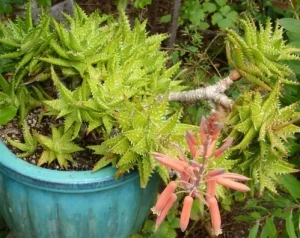
The flowers of the aloe juvenna are a deep red, almost purple color. They are borne on spikes that can grow up to two feet tall. The fragrance of the flowers is sweet and musky, with a hint of citrus.
The blooms appear in late summer and early fall and last for several weeks. Aloe juvenna is a great plant for adding color and interest to the garden during the late summer and early fall months.
Growth rate
Aloe juvenna is a fast-growing succulent that can reach up to 12 inches in height. This aloe is characterized by its triangular, tooth-like leaves that are arranged in a rosette pattern.
The leaves are green with white stripes and have sharp tips. Aloe juvenna prefers full sun but can tolerate partial shade. It is drought-tolerant and does not need much water to survive.
Toxicity
Aloe juvenna is non-toxic and therefore considered safe to both humans and pets, so you do not need to worry about toxicity when dealing with this plant.
USDA hardiness zones
Aloe juvenna thrives best in USDA hardiness zones 9-11, but can be grown as far north as zone 8. The plants are frost-tolerant and typically do not have any pest problems. They are low maintenance and will grow with only minimal water during the summer months.
Pests and diseases
Unfortunately, Aloe juvenna plants are susceptible to a number of pests and diseases. The most common include mealybugs, aphids, scale, spider mites, and root rot. Left unchecked, these problems can quickly kill your plant.
However, there are a few things you can do to prevent or treat them. If the plant is showing signs of insect damage, such as small holes in the leaves, it may be helpful to dust the leaves with horticultural oil once a week.
One teaspoon mixed with water should be enough for an average-sized pot. For infestations, use neem oil on both sides of the leaf every five days for two weeks or until the infestation is gone.
Be sure not to use neem oil on variegated varieties because it will turn them brown.
